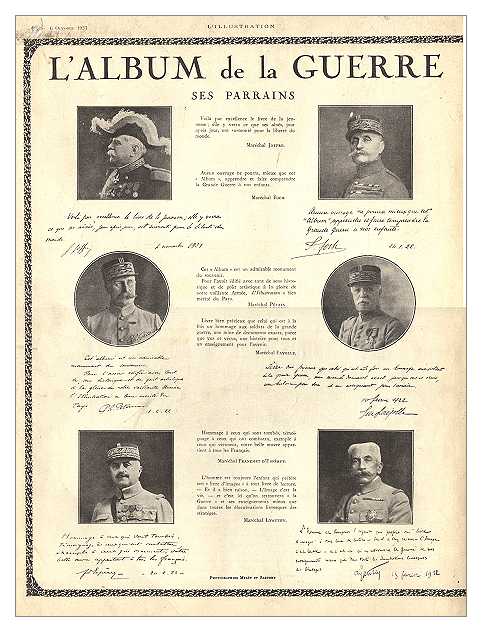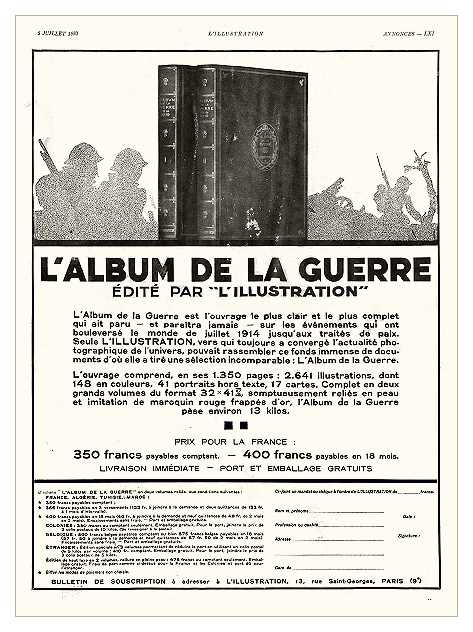

Journalistic Excellence and Patriotism


Without a doubt, the French news weekly 'L'Illustration' was the most prestigious and lavishly printed periodical of the Great War. 'l'Illustration was founded in 1843 and was famed for its lavish use of illustrative material - hence the name. Up to the beginning of the 20th century, imagery in this large-sized publication was technologically restricted to the use of woodcuts and metal etchings. But following new advances in printing techniques, 'l'Illustration' was soon offering quality photographs in its pages. By the time of the Russo-Japanese war of 1904-05, articles on this war were often accompanied by on-the-scene photographs of battlefields and besieged cities or sunken naval vessels.
Always a quality publication, 'l'Illustration' was at its best when reporting wars - at first far-off actions in Manchuria or the Balkans - later on the battlefields of France and Russia, the Dardanelles and the Balkans once again. And it was here, during the years 1914-1919 that l'Illustration transformed itself into a French patriotic publication of quality, printing distinctive and striking photographs, illustrations and articles pertaining to the great world war. 'L'Illustration' is now remembered for the printing of lavish, two-page color illustrations, a then somewhat extravagent luxury in news magazines. These illustrations, in color or otherwise, were done by renowned and proficiently gifted French illustrators and artists such as Georges Scott, Francois Flameng, Lucien Jonas, Charles Fouqueray, L. Sabattier, J. Simont and many others.
L'Illustration was printed in a large A3 format on heavy glossy stock paper. The outside cover was of even heavier protective stock, uniformly printed with vignette and text, only differing each week in issue number and date. Once this outside cover and advertising was removed, one had the integral publication itself, with an inside cover featuring a large sized photograph or illustration. A preponderance of articles featured subject matter dear to heart of every gallant and patriotic Frenchman, though it is notable that once the United States entered the war, American subjects were treated with great regularity. Many illustrations from 'L'Illustration' were reprinted in other magazines worldwide, both in Allied, Neutral and Central Powers countries. Many classic Great War photographs, that are usd in modern day history books, were taken from the pages of 'L'Illustration' where they were first published, though in a somewhat different layout and presentation.
'L'Illustration' was not only renowned for its graphic excellence but also for its articles and written pieces. At the war's beginning, text articles were short and not always factually informative. As the war progressed however, articles became longer and more specific in regards to fact and events as well as more informative and explanatory. By the war's end, written text articles often spanned several full pages - articles written in series on a specific military event would often be as long as a full length book and just as informative and interesting. Besides top class illustrators, 'L'Illustration' also employed many first rate journalists of the written word - Gustave Babin, well versed in military matters, wrote from 1914 onwards till 1919, as fully accredited journalist to the French army at the front, Robert Vaucher was a talented Swiss citizen who worked for the magazine on many foreign fronts - Italy, Albania, Serbia, Greece, Russia, Austria, Hungary and in newly independant Poland - his travels far and wide brought an element of exotic romanticism, rugged hardship and descriptions of revived national hope and brutal dictatorship to French readers, Charles Rivet and Edouard Julia reported from Czarist Russia, while other gifted and award-winning literary writers such as Henri Lavedan and Pierre Loti wrote editorials and opinion pieces, often stirring and moving, but always patriotically inspired and distinctive in their elegant use of the French language.
Many articles by the above journalists and others as well, can be accessed via links on the following page - textes en Franšais - all are in the original French.
Pre-war circulation of 'l'Illustration' was around 80 000 weekly, but during the war-years the magazine averaged print-runs of 300 000 to 400 000 issues weekly, a dramatic and no doubt very profitable four-fold increase. After the war, circulation dropped to around 50 000 weekly. Clearly the Great War was a boon to many magazine publishers in France. This large boost in circulation is even more remarkable when the considerably high price of a single issue - 1.00 to 1.25 french francs - is taken into account. Other cheaper illustrated newsmagazines selled for as little as 15 to 25 centiemes, although of course they never came close to achieving the same outstanding appearance and look of 'l'Illustration'.
After the war, a two volume leather bound Commemorative Album was printed which featured a selction of the most notable photographs, illustrations and articles that appeared in the magazine during the war years. This two volume album was still in print during the late 1930's and enjoyed a vast print-run. The albums are of such obvious worth and prestige that they have usually been well cared for over the years. Consequently, even now they are relatively easily and cheaply availible on the secondhand book market. Anyone beginning a collection of Great War magazines would be best advised to procure a copy of these elegantly published Commemorative Albums.
Aside from the 2 volume Commemorative Album, all war-time issues of L'Illustration, from July 1914 til July 1919 were either reprinted or bound into volumes from existing war-time surplus issues. Aside from single reprints which were indicated as such on the front outside cover, the other contents being faithfully reprinted, a vast (and extremely weighty) 10 volume leather bound special collection of all war time Illustration issues was also published during the 1920s. These are somewhat more difficult to find nowadays, but are well worth acquiring. Anyone wishing to learn more about the Great War from a French perspective, to try and grasp the feeling and mood of the times as it was experienced in war-time France, is best advised to start with the contents of 'l'Illustration'. No other contemporary publication comes close, no other publication achieves such graphic and artistic excellance.
Here is a small and more or less representative collection of 38 covers from l'Illustration, starting from the early days of the war until and after the Armistice.


Advertisements for the 2 volume 'Album Commemorative'
A Collection of Inside Covers
'In Flanders Fields'


To a Collection of Covers